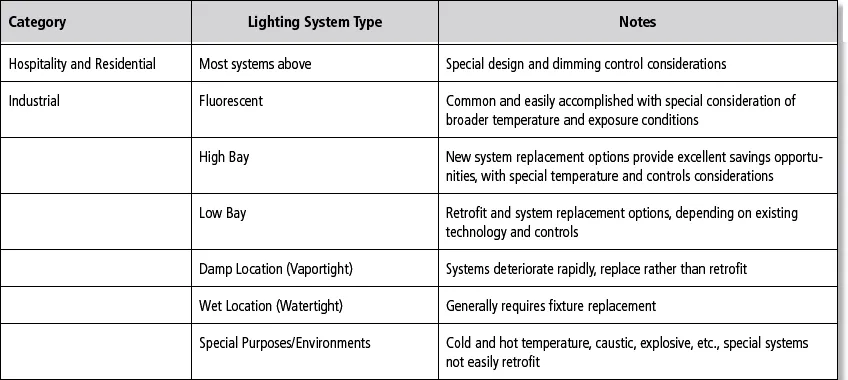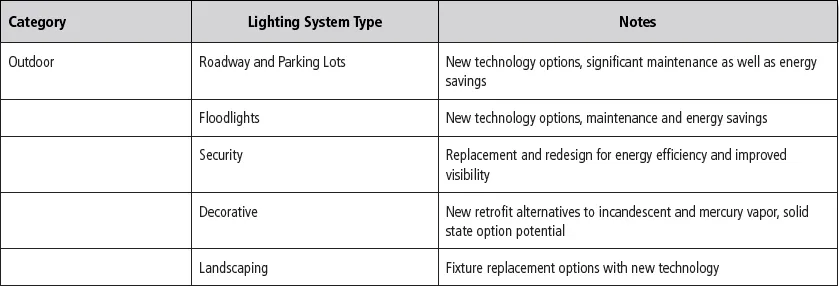![]()
While categorizing by technology avoids repeated discussion of typical lamp- and ballast-based retrofit solutions, the special applications categories are useful in discussing unusual environments and control options. Included for each of these categories is:
General discussion of retrofit in the category
Brief descriptions of typical existing conditions
A discussion of specific retrofit options with guidelines for assessing those options. Tables are provided to quantify specific retrofit savings opportunities by lamp/ballast and luminaire type.
Guidelines for use of lighting controls are discussed in brief in each chapter, as their use may differ from one application and lamp source to another (see following table).
Case studies are offered to relate real-world conditions, where nothing goes exactly as planned. Retrofit often requires a flexible approach to specifying and installing components and lighting controls. The “if this, then that” scenario of specification often seems to work the best, as no matter how carefully you evaluate a facility, there will usually be surprises upon installation.
COMMERCIAL LIGHTING SYSTEMS
Commercial lighting includes the lighting systems used in office buildings, institutions, stores, schools, and all other nonindustrial buildings. Each of the three major lighting systems has broad application in commercial buildings. Industrial lighting systems are often found in environmentally severe conditions. Hospitality, including hotels, restaurants, and spas, is similar to residential lighting in aesthetic demands, but often uses commercial lighting technologies. The need to control these systems by dimming places greater demands for lighting technology improvements in the hospitality sector.
Outdoor lighting systems are unique applications, operating in a broad range of temperatures and climate conditions. Recent technological developments bring new options to the table for this large sector of the lighting market.
Commercial lighting constitutes about 40 percent of the electric lighting load in the United States. Most commercial lighting systems, other than hospitality and retail display lighting, are based on fluorescent and HID lamps. While the design of fluorescent lamps and ballasts has evolved considerably over the last 40 years, much of the older fluorescent technology is still in place, and until recent changes in federal legislation has been commonly sold in the United States. Even the newest products bear strong physical resemblance to the oldest fluorescent products. The general public, therefore, does not always understand the difference between the poor color quality, noisy, magnetically ballasted T-12 technology of the past, and significantly improved properties of the more advanced, high-efficiency T-8 and T-5 fluorescent systems. Many engineers and local lighting distributors are also not aware of recent advances in high performance lamp and ballast technology, and may not be making optimal selections for efficiency. Rather, sales are often based on what is commonly available.
LIGHTING SYSTEM RETROFIT APPLICATIONS
Lacking assistance and/or intervention by federal and state energy efficiency mandates and programs, obtaining high performance options may involve more hassle and cost than should be the case. However, federal laws prohibit the sale of outdated and inefficient light sources, and higher electricity costs will inevitably bring higher efficiency fluorescent lamp and ballast technology into greater use.
Commercial application of hardwired compact fluorescent (CF) luminaires (as opposed to screw-based compact fluorescent lamps), especially in recessed can lighting, started in the 1980s. The significant energy benefits of hardwired compact fluorescent luminaires, using “permanent” ballast and pin-based compact fluorescent lamps, brought early adoption in many engineered buildings. Compact fluorescent fixtures installed before 2000, and many lower wattage CF fixtures even today, use magnetic ballasts. With the Department of Energy′s “Energy Star” rating of electronically ballasted hardwired luminaires, we are now seeing considerable improvement in energy and starting performance for residential luminaires. Commercial luminaires typically have not been evaluated, but often use ballasts that meet or exceed the Energy Star specifications.
Compact fluorescent screw-based lamps (CFL) have become ubiquitous as a retrofit application in all types of buildings where the simplicity of this retrofit has helped overcome initial, as well as continuing, resistance to a full changeover from incandescent sources. More discussion of this category of retrofit option is included in Chapter 2.
High Intensity Discharge (HID) systems have undergone significant improvements as well. The advent of electronic ballasts for metal halide lamps, and the improved color, wattage options, and efficiency of lamps that use them, is creating energy efficient options for commercial, and especially retail, industries heavily dependent on HID pendants and track lighting. Metal halide PAR lamps, relatively indistinguishable from incandescent to the layperson, are a significant efficiency improvement over halogen PAR lamps for the retail industry. Energy efficient pulse-start technology is rapidly replacing older forms of magnetic ballast technologies in other forms of metal halide lighting. See Chapter 3 for more information on this topic.
The remainder of commercial lighting systems include incandescent lighting in common luminaire types such as can downlights and surface-mounted or pendant decorative fixtures. While many manufacturers now offer hardwired compact fluorescent, HID, and solid state lighting options for new construction and relighting applications, new lamp technologies continue to offer good retrofit opportunities in certain types of decorative luminaires.
EMERGING LIGHTING TECHNOLOGY
With the advent of solid state lighting development, there is now an explosion in the number of lamps and luminaires offered with this technology. At the time of this writing, a number of innovative products have been introduced for use in existing luminaires. Many of these will gain better acceptance as the following concerns are addressed:
- Light output and requirements for heat dissipation are related concerns in solid state technology. LEDs can function in many applications, but their output may not be equivalent to incandescent or halogen counterparts. Higher output LEDs need effective methods of removing heat from the small light source, presenting more than a small technical challenge in a luminaire not designed to do this.
- LEDs are excellent at producing directional light. This makes recessed and directional lighting ideal applications, while replacing the standard incandescent “A” type lamp is a greater technical challenge. With the incentive of a $10 million reward for developing the ideal A-lamp replacement, the world′s manufacturers are already producing some intriguing options.
Solid state, as LED systems, will be discussed throughout this book. As a retrofit technology, they are included for consideration as an alternative to an existing lighting technology. As such, there is no separate chapter dedicated to solid state lighting.
Energy Policy Act of 2005 EPAct, among other measures set minimum ballast efficacy standards and created deadlines to cease production of inefficient ballasts.
![]()
CHAPTER 1
Linear Fluorescent Systems
THE MOST COMMON COMMERCIAL LIGHTING SYSTEMS are based on the 4′ or 8′ fluorescent lamp. The older “T-12” technology is now obsolete, and a high percentage of the T-12 lighting systems have been retrofit with newer “T-8” lamps since the early 1990s, when electric utilities in some parts of the United States created retrofit incentive programs for its customers. However, despite partial bans on the technology, magnetic ballasts and T-12 lamps have remained available in the marketplace, even though T-8 lamps and ballasts are more economical and energy efficient.
This has changed as of October 2009 when most magnetic T-12 ballasts are no longer sold for replacement through electrical distribution. An opportunity exists to replace—and properly dispose of—the quantities of magnetic ballasts that remain in many commercial facilities. Fortunately, replacement of these systems with the newest high performance T-8 systems makes simple lamp and ballast retrofits more cost effective than ever.
The more common the retrofit of specific lighting systems has become, the better the assurance of successful results. Not only do the products and their quality improve, but installers become accustomed to installing them using cost-effective methods. However, products that made sense five years ago may not be the only choice today.
For this reason, this book includes a number of promising new options as well as tried and true products and techniques in the following chapters. Through an increasing array of retrofit options, costs and affordability will improve for even the smaller lighting retrofit projects—those often left after the first waves of retrofit frenzy have passed.
The ability to reduce energy through linear fluorescent retrofits is a function of several options. Consider all of the following (discussed in more detail in Part II on the retrofit process) in selecting retrofit options.
- Efficiency of the lamp/ballast and luminaire. This is often the sole focus of fluorescent lighting retrofits, but it is only part of the equation.
- General layout (square feet per fixture). The coverage area per luminaire is critical in determining design lighting level, new lighting level, and any opportunities for intentional lighting level reduction. This is an important element in a luminaire replacement programs where the light distribution patterns from old to new luminaire may be very different.
- Room surface finishes. Illuminance requirements are reduced when rooms with dark surfaces are repainted to lighter colors or ceiling tiles replaced when existing tiles are soiled or not white. Improving light levels by increasing room surface reflectance allows as much as 25 percent reduced lighting power with no perceived change in room brightness.
- Illuminance level. Reduce lighting levels as appropriate if the space is overlighted.
Additional information on these topics is available in Chapter 7, Lighting Engineering and Evaluation.
HIGH EFFICIENCY FLUORESCENT LAMPS AND HIGH PERFORMANCE BALLASTS
T-8 lamps and electronic ballasts have been used for the last 20 years to improve energy performance in linear fluorescent lighting systems. Since the early 1990s, a series of further advances in fluorescent lamp and ballast technology allow significant additional savings. “High performance” or “super” T-8 systems currently a...




